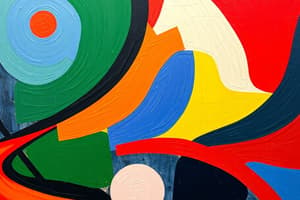Podcast
Questions and Answers
According to the definition of art, what is the primary role of an artist?
According to the definition of art, what is the primary role of an artist?
- To reflect reality accurately
- To defy the laws of nature
- To replicate nature precisely
- To complete what nature cannot bring to a finish (correct)
What type of art is concerned with the creation of three-dimensional objects?
What type of art is concerned with the creation of three-dimensional objects?
- Literature
- Music
- Painting
- Sculpture (correct)
What is the term for the empty spaces created by the artist around, between, and within the subjects?
What is the term for the empty spaces created by the artist around, between, and within the subjects?
- Negative space (correct)
- Positive space
- Unique space
- Aesthetics
What is the primary characteristic of a horizontal line in art?
What is the primary characteristic of a horizontal line in art?
What is the term for the distances or areas around, between, and within components of a piece?
What is the term for the distances or areas around, between, and within components of a piece?
What does a jagged line typically represent in art?
What does a jagged line typically represent in art?
What is the main difference between organic and geometric shapes?
What is the main difference between organic and geometric shapes?
What is the main characteristic of a form in art?
What is the main characteristic of a form in art?
What is the main difference between hue and color?
What is the main difference between hue and color?
What is the term for the lightness or darkness of a color?
What is the term for the lightness or darkness of a color?
Flashcards are hidden until you start studying
Study Notes
Definition of Art
- Art completes what nature cannot bring to a finish, and the artist gives us knowledge of nature's unrealized ends.
- Art is a mediator of the unspeakable, and it searches for individualism.
- Art is an expression of man's ideas, imagination, and emotions through the use of his body.
Characteristics of Art
- Man-made
- Unique
- Aesthetics
Types of Art
- Painting
- Sculpture
- Architecture
- Literature
- Music
Elements of Art
Space
- Refers to the distances or areas around, between, and within components of a piece.
- Positive space refers to the subject of the piece itself.
- Negative space refers to the empty spaces the artist has created around, between, and within the subjects.
Line
- Indicates direction, orientation, movement, and energy.
- Vertical line represents power, strength, stability, simplicity, and efficiency.
- Horizontal line creates an impression of serenity and perfect stability, rest, calmness, peace, and repose.
- Jagged line shows violence, confusion, and conflict.
- Curved line shows a gradual change of direction and fluidity and signifies subtle form.
Shape
- An enclosed space, a bounded two-dimensional form that has both length and width.
- Boundaries are defined by other elements of art such as line and space.
- Organic shapes are based on natural or living forms and can be irregular.
- Geometric shapes are based on measured forms.
Form
- Connotes something that is three-dimensional and encloses volume, having length, width, and height.
- Geometric forms are mathematical, precise, and can be named, as in the basic geometric forms: sphere, cube, pyramid, cone, and cylinder.
- Organic forms are free-flowing, curvy, sinewy, and are not symmetrical or easily measurable or named.
Color
- Produced when light, striking an object, is reflected back to the eye.
- A sensation, a human reaction to a hue arising in part from the optic nerve, and in part from education and exposure to color.
- Classification of colors:
- Primary colors: colors that cannot be formed from mixtures because they are pure colors (e.g. Red, Blue, and Yellow).
- Secondary colors: colors formed out of combination of two primary colors (e.g. Blue + Yellow = Green; Red + Blue = Violet; Red + Yellow = Orange).
- Intermediate colors: colors formed out of mixing one primary and one secondary (e.g. Yellow + Green = Yellow green; Red + Violet = Red violet; Red + Orange = Red orange).
- Hue: refers to the names we assign a color.
- Saturation: refers to the vividness of color.
- Value: refers to the lightness or darkness of the color.
Texture
- Used to describe the way a three-dimensional work actually feels when touched.
- In two-dimensional work, such as painting, it may refer to the visual "feel" of a piece.
Studying That Suits You
Use AI to generate personalized quizzes and flashcards to suit your learning preferences.




